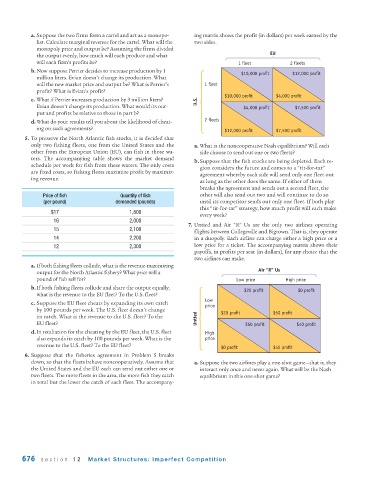Page 718 - Krugmans Economics for AP Text Book_Neat
P. 718
a. Suppose the two firms form a cartel and act as a monopo- ing matrix shows the profit (in dollars) per week earned by the
list. Calculate marginal revenue for the cartel. What will the two sides.
monopoly price and output be? Assuming the firms divided
the output evenly, how much will each produce and what EU
will each firm’s profits be? 1 fleet 2 fleets
b.Now suppose Perrier decides to increase production by 1
$10,000 profit $12,000 profit
million liters. Evian doesn’t change its production. What
will the new market price and output be? What is Perrier’s 1 fleet
profit? What is Evian’s profit?
$10,000 profit $4,000 profit
c. What if Perrier increases production by 3 million liters? U.S.
Evian doesn’t change its production. What would its out- $4,000 profit $7,500 profit
put and profits be relative to those in part b?
2 fleets
d.What do your results tell you about the likelihood of cheat-
ing on such agreements? $12,000 profit $7,500 profit
5. To preserve the North Atlantic fish stocks, it is decided that
only two fishing fleets, one from the United States and the a. What is the noncooperative Nash equilibrium? Will each
other from the European Union (EU), can fish in those wa- side choose to send out one or two fleets?
ters. The accompanying table shows the market demand
b.Suppose that the fish stocks are being depleted. Each re-
schedule per week for fish from these waters. The only costs
gion considers the future and comes to a “tit-for-tat”
are fixed costs, so fishing fleets maximize profit by maximiz-
agreement whereby each side will send only one fleet out
ing revenue.
as long as the other does the same. If either of them
breaks the agreement and sends out a second fleet, the
Price of fish Quantity of fish other will also send out two and will continue to do so
(per pound) demanded (pounds) until its competitor sends out only one fleet. If both play
this “tit-for-tat” strategy, how much profit will each make
$17 1,800
every week?
16 2,000
7. Untied and Air “R” Us are the only two airlines operating
15 2,100
flights between Collegeville and Bigtown. That is, they operate
14 2,200 in a duopoly. Each airline can charge either a high price or a
12 2,300 low price for a ticket. The accompanying matrix shows their
payoffs, in profits per seat (in dollars), for any choice that the
two airlines can make.
a. If both fishing fleets collude, what is the revenue-maximizing
Air “R” Us
output for the North Atlantic fishery? What price will a
pound of fish sell for? Low price High price
b.If both fishing fleets collude and share the output equally,
$20 profit $0 profit
what is the revenue to the EU fleet? To the U.S. fleet?
Low
c. Suppose the EU fleet cheats by expanding its own catch
price
by 100 pounds per week. The U.S. fleet doesn’t change $20 profit $50 profit
its catch. What is the revenue to the U.S. fleet? To the Untied
EU fleet? $50 profit $40 profit
d.In retaliation for the cheating by the EU fleet, the U.S. fleet High
also expands its catch by 100 pounds per week. What is the price
revenue to the U.S. fleet? To the EU fleet? $0 profit $40 profit
6. Suppose that the fisheries agreement in Problem 5 breaks
down, so that the fleets behave noncooperatively. Assume that a. Suppose the two airlines play a one-shot game—that is, they
the United States and the EU each can send out either one or interact only once and never again. What will be the Nash
two fleets. The more fleets in the area, the more fish they catch equilibrium in this one-shot game?
in total but the lower the catch of each fleet. The accompany-
676 section 12 Market Structures: Imperfect Competition

